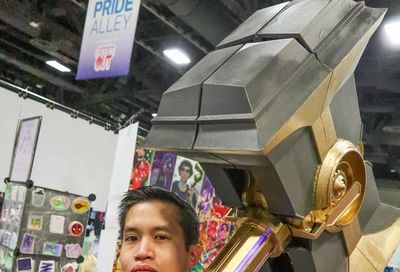‘Indiana Jones and The Dial of Destiny’ Review
Harrison Ford swings back into Indy action with an energized, emotional turn in Indiana Jones and the Dial of Destiny.

Speaking for legions of displeased Indiana Jones fans, the creators of South Park registered a fairly popular opinion of the 2008 blockbuster Indiana Jones and the Crystal Skull in an episode depicting Steven Spielberg and George Lucas “raping” Indy, while Stan, Kyle, and the boys watched on in horror.
The world was able to move on from Crystal Skull, which offers at least a memorable villain in Cate Blanchett’s sword-wielding Soviet agent Irina Spalco. But the film — the fourth in the franchise, all directed by Spielberg with stories by Lucas — is still laughably dull in parts, and too stupid to be believed in others.
Most of both those parts involve Shia LaBeouf’s Mutt Williams, Indy’s surprise son, seen in one scene swinging through the jungle treetops, Tarzan-style, alongside an army of CGI monkeys.
Mutt doesn’t appear in Indiana Jones and the Dial of Destiny (★★★☆☆), Indy’s latest adventure and perhaps Harrison Ford’s farewell to the iconic character, but the next-gen Jones does warrant a meaningful mention in this well-wrought tale that finds intrepid archaeologist Jones in 1969, chasing down another powerful relic, this time with the help of someone else’s kid.
Directed by Ford v Ferrari and Logan Oscar nominee James Mangold, the film teams Indy with his goddaughter, Helena, played with sharp glints of greed and ambition by Fleabag phenom Phoebe Waller-Bridge.

Educated as an archaeologist herself, Helena baldly craves what Indy mostly shies away from — fame and glory, the aura of which has faded for Dr. Jones, who’s like a relic himself, teaching a class of university students who’d rather be watching a telecast of the moon landing.
Ford, 80, gamely brings out the “cranky old guy in boxers” version of Indiana Jones for a laugh and a genuine nod that Indy’s adventures, and these movies, recall a bygone era of swashbuckling heroes, conniving villains, and cliffhanging suspense. In 1969, or in the TikTok 2020’s, Indiana Jones isn’t automatically afforded relevance just because of past deeds. He works for it.
The film flashes back frequently to a 1944 backstory detailing the friendship between Jones and Helena’s father, Basil (well-played by Toby Jones), an explorer who apparently was driven mad searching for pieces of the titular artifact, an astronomical instrument of mysterious purpose.
Battling his nemeses the Nazis in 1944, younger Indy — a visual effect combining stunt double Mike Massa and Ford’s face, de-aged through CGI — looks surprisingly good, if not seamlessly rendered. The effects throughout are well-integrated with the live action, locations, and studio-shot sequences to produce exciting setpieces like a chase on horseback through midtown Manhattan that gallops down into the subway (shot largely in Glasgow, and at Pinewood Studios), or a wild tuk-tuk chase through Tangier (shot in Morocco).
Attempts to recapture the delightful creepy-crawly thrills of the Spielberg films, with an underwater eel attack and a scene that finds Indy and Helena drenched in insects, don’t hit that nerve. But the filmmakers do drum up sweet nostalgia with John Williams’ hard-working score, the famous hat and whip, and the return of Sallah, Indy’s occasional partner in adventure, introduced in Raiders of the Lost Ark, and still played by the ever-lovable John Rhys-Davies.
The movie also introduces a new kid sidekick in the form of Ethann Isidore’s spunky pickpocket Teddy, but let’s just say Teddy is no Short Round. And, while the race to assemble the Dial of Destiny and determine its purpose takes some outlandish turns, Ford, as engaged as ever playing Dr. Jones, invests the film with a gravity that feels new to the character and ensures that this story doesn’t feel lightweight.
Visibly bearing the tolls of his wins and his losses, Indiana Jones isn’t the man he used to be, but he’s still the timeless hero he’s always been.
Indiana Jones and the Dial of Destiny is playing in theaters nationwide. Visit www.fandango.com.
Support Metro Weekly’s Journalism
These are challenging times for news organizations. And yet it’s crucial we stay active and provide vital resources and information to both our local readers and the world. So won’t you please take a moment and consider supporting Metro Weekly with a membership? For as little as $5 a month, you can help ensure Metro Weekly magazine and MetroWeekly.com remain free, viable resources as we provide the best, most diverse, culturally-resonant LGBTQ coverage in both the D.C. region and around the world. Memberships come with exclusive perks and discounts, your own personal digital delivery of each week’s magazine (and an archive), access to our Member's Lounge when it launches this fall, and exclusive members-only items like Metro Weekly Membership Mugs and Tote Bags! Check out all our membership levels here and please join us today!


























You must be logged in to post a comment.